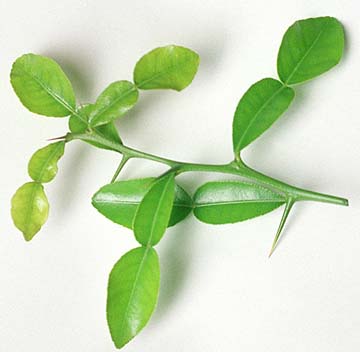

Key Ingredient

|
KAFFIR LIME LEAVES
Next to lemongrass, kaffir lime leaves best define Thai cuisine. Restaurateur and cookbook author Mai Pham goes so far as to say, "If it were not for kaffir limes, Thai cuisine as we know it would not exist!"The leaves are a flavoring agent used to give soups, curries and stir-fries that distinctive citrus taste and aroma. Although ordinary lime zest can be substituted in recipes, it is worth seeking out kaffir leaves when called for.
The basics: The leaves are from the kaffir lime tree, which is indigenous to Southeast Asia. The trees thrive in Hawaii, where much of the crop is exported to the U.S. mainland.
The leaves are dark green with a glossy finish. They are also uniquely shaped in a figure-eight form with two leaves attached end to end. The size of the leaves varies greatly from less than an inch to a couple of inches long. The kaffir lime fruit, with its distinctive bumpy rind, is also used, but more for its peel than its juice.
Selecting: Kaffir lime leaves are sold fresh or dried. Dried leaves should be soaked in hot water before using. Fresh leaves were once difficult to find, but are now readily available year-round. They are most often sold in pre-packaged 1-ounce bags. Look for fresh, bright green and glossy leaves. Avoid leaves that look dry or brittle or have dark spots.
Storing: Leaves will keep for a couple of weeks refrigerated in a plastic bag. They also freeze well and will keep for months that way.
Use: Just a couple of leaves will impart a strong essence in any recipe. The leaves can be used whole like bay leaves in soups and curries, or thinly slivered in stir-fries. Lemongrass and kaffir lime leaves often go hand-in-hand in Tom Yum soup and Thai curries, or try a stir-fry of shrimp, garlic, red chilies, fish sauce and kaffir lime leaves. The leaves can also be infused in tea or substituted for lime zest in creamy desserts.
Where to buy: Chinatown and most Asian markets carry the leaves year-round, at about $1 for a 1-ounce bag.
Food Stuffs: Morsels
Eleanor Nakama-Mitsunaga is
a free-lance food writer. Contact her
online through features@starbulletin.com